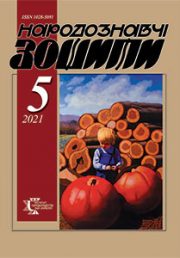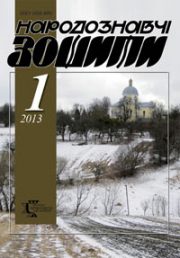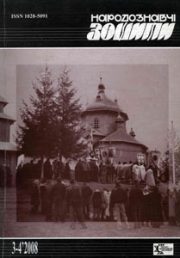The Ethnology Notebooks. 2020. № 3 (153), 532—557
UDK 398.8:94 (=161.2)(355.48)”19″
DOI https://doi.org/10.15407/nz2020.03.532
THE CONFLICT OF IDEAS IN THE FOLKLORE OF UNR AND ZUNR PERIOD (SOURCES, GENRES, IMAGES, FIGURES)
KUZMENKO Oksana
ORCID ID: https://orcid.org/0000-0002-0512-6388
Candidate of Philological Sciences (Ph. D. in philology),
Senior Researcher at the Ethnology Institute
of National Academy of Sciences of Ukraine,
15, Svobody Avenue, 79000, Lviv, Ukraine,
Contacts: е-mail: kuzmenko.oksana@gmail.com
Abstract. The article presents a conceptual analysis of folklore pertaining to the activity of the Ukrainian People’s Republic (UNR) and the Western-Ukrainian People’s Republic (ZUNR). The purpose of this study is to identify the peculiarities of the «folklore» version of history and scholarly & academic discourse of the 1917—1920’s. The main task was to show the depth of the conflict of state-building ideas along the axis «people (peasants) — politicians», the multivectoral vision of the political project «Ukraine» in Galicia, Bukovina and Dnieper Ukraine regions. Due to the fact, that the sources are utterly scattered, there are no authentic texts of historic folklore depicting the events of the Ukrainian revolution and the civil war.
The author investigates the peculiarities of works including the satirical couplets and chastivkas, lyrical and epic songs, oral stories, narrative memorates. A complex analysis of regional traditions (Lviv, Kyiv, Zaporizhzhia, Vinnytsia regions), which is the object of this analysis, showed that despite the locally specific thematic groups, there is a strong general folklore conceptual basis revealing itself in the depiction of the enemy-conqueror, the motives of combatant’s fatal death of a soldier, cruelty of captivity. The folklore concepts, which make the subject of this research, bear the semantics of significant moral and philosophical categories of existence pivoting around the oppositions: sin/punishment, human/inhuman, good/evil, truth/falsehood. The author investigates «Lviv» tales and the song paradigm And on Sunday morning before the sun goes up (A v nediliu rano shche sontse ne skhodyt’) which indicate that folk works disclose a set of problems causing the defeat in 1918—1919 Ukrainian-Polish war. They are coded with the dramatic motives of fatal death due to the epidemics of typhus, images of starvation and misery amongst the army troops, motivemes captivity and betrayal. It is proven that the works are traditional and folklore-based which is seen in the actualization of resources of folklore language, epic images and stylistics.
The author has underlined historical prototypes and semantic markers of wartime activists (Anton Denikin, Nestor Makhno, Myron Tarnavsky). Among them most of attention is paid to analysis of the ambivalent UNR Chief Symon Petlura (leader / traitor) and peculiarities of the folklorization of the historic Warsaw Pact event of April 21, 1920.
It is summarized that the folklore text articulates the relevant hazards of the political crisis. The latter bases itself in the political illiteracy of the population, feeds on the passiveness, chaos in actions from the side of the bulk of Ukrainian peasants, and these paved way for a complicated scheme of civil war and altogether caused the loss of chances to build a united national state.
Keywords: historical folklore, regional folk, tradition, genre, motif, image, war, Ukrainian People’s Republic, Western-Ukrainian People’s Republic, S. Petlura, N. Makhno, A. Denikin.
Received 26.05.2020
REFERENCES
Kuzmenko, O. (2009). Rifleman Songs: Folklorism, Folklorization, Folklore. Lviv [in Ukrainian].
Irchan, M. (1919). Makhno and Makhnovists. Impressions of an Eyewitness. Kaminets [in Ukrainian].
Levchenko, M. (1926). Peasants’ Stories About the Times of the Civil War in Ukraine. Etnohrafichnyi Visnyk, 2, 68—75 [in Ukrainian].
Baran, M. (2002). (Ed.). Ukrainian Galician Army: ACollection of Memoirs. Lviv [in Ukrainian].
Mitrofanenko, Y. (2016). Ukrainian Otamanshchyna 1918—1919. Ed. 3-rd. Kropyvnytskyi [in Ukrainian].
Levitskyi, O. (1921). Galician Army in Greater Ukraine (memories from July to December 1919). Vienna [in Ukrainian].
Kuzmenko, O. (2005). (Ed.). Rifleman Songs. Lviv [in Ukrainian].
Skidan, M. (1936). The Path of the First Galician Corps in Its Ccampaign to Kyiv. Litopys Chervonoii Kalyny, 2, 7—10 [in Ukrainian].
Zavalnyuk, O.M., & Oliynyk, S.V. (2013). Ukrainian Galician Army in Podillya (From July 1919 — To May 1920). Kamyanets-Podilsky [in Ukrainian].
Kuzmenko, O. (2006). Folklore Records from Eastern Podillya; Khmelnytsky, Vinnytsia regions. Archive of the IN NANU (Archive of the Institute of Ethnology of the National Academy of Sciences of Ukraine). F. 1. Op. 2. Od. save 552. Arc. 1—127 [in Ukrainian].
Pashchenko, E.M. (2008). (Ed.). Ukrainian political folklore. Kyiv [in Ukrainian].
Myshanych, S. (1983). (Ed.). Folk Stories. Kyiv [in Ukrainian].
Babii, O., Zarytskyi, V., Grechanivskyi, D., & Bilynskyi, B. (1969). (Ed.). Ukrainian Corps of the Sich Riflemen: A military-historical study. Published by the Jubilee Committee for the Sich Riflemen. Chicago [in Ukrainian].
Pavlenko, I., & Polyakova, N. (2005). Spiritual Treasures of Our Land. Folklore of Berdiansk District of Zaporizhia Oblast: A Collection of Folklore Works. Zaporizhia [in Ukrainian].
Nazaruk, O. (1920). Year in Greater Ukraine. Synopsis of memoirs from the Ukrainian revolution. Vienna [in Ukrainian].
Kushnirenko, I., & Zhilinsky, V. (2002). Folklore of Huliaipole Area: Zaporizhia Oblast. Dnipropetrovsk [in Ukrainian].
National Library in Warsaw. Department of Microfilms (abbreviated — NB in Warsaw). F. Archive of NTSh. M/f № 87502 (XXIV-27. Memories of One of the Adjutants of the UGA Main Command From the Events of 1919) [in Ukrainian].
Kuzmenko, O. (2009). Folk Prose About Sich Riflemen: A ScholarlyCollection. Archive of the Institute of National Academy of Sciences of Ukraine. F. 1. Op. 2. Od. zb. 613. Arc. 1—201 [in Ukrainian].
Yeremiyiv, M.E. (1974). Konovalets Against the Background of the Ukrainian Liberation War. In Yevhen Konovalets and His Time (Pp. 115—165). Munich.
(1922). Hey don’t be surprised…: War Songs. Lviv: Svitanok [in Ukrainian].
Khoma, I.Y. (2012). Battles for Berdychiv by the Units of the Ukrainian People’s Republic Army Against the Bolshevik troops. Bulletin of the National University «Lviv Polytechnic». Series: State and Army, 724, 147—152. Lviv [in Ukrainian].
NB in Warsaw. F. Archive of NTSh. М/f № 87262. (1460 ХI.1—31. Minor Documents of the Ukrainian Sich Rilefmen, Including the Ledger Book of the 61-th Hospital of Red Cross. 1914—1920) [in Ukrainian].
Oleksieva, O.V., & Bilyi, V.V. (1925). Short Songs («chastushki») from 1917—1925. Ethnographic Bulletin, 1, 22—36 [in Ukrainian].
Kovalchuk, M. (2006). The Unknown War of 1919: Ukrainian Armed Confrontation with the White Guard. Kyiv [in Ukrainian].
NB in Warsaw. F. Archive of NTSh. M/f № 69010. (Journals, diaries. 1918—1922) [in Ukrainian].
Kryvoshyi, O.P. (2011). «Memories of Women’s Participation in the Civil War and the Women’s Movement» as a Source for Studying the History of Southern Ukraine in 1918—1924. Museum Bulletin, 11, 155—177 [in Ukrainian].
Kuzmenko, O. (2008). Ukrainian Folklore About the Sich Riflemen: Some Aspects of Historical Reality and Folklore Aesthetics. East — West. Historcal and Cultural Collection (Issue 11—12, pp. 138—149). Kharkiv [in Ukrainian].
Kuzmenko, O. (2015). Riflemen Theme in the WWI Folklore Prose (or, The Motifs From the Past Before theChallenges of Modern Times). From the History of Western Ukraine (Issue 10—11, pp. 257—277) [in Ukrainian].
Hnatiuk, Yu., & Mykytiuk, D. (1977). (Ed.). The Ukrainian Rifleman: Organ of the Press Apartment of the Ukrainian Brigade in Czechia. Yearbooks 1920—1921. Winnipeg [in Ukrainian].
Kuzmenko, O. (2018). Dramatic Human Existence in Ukranian Folklore: Conceptual Forms of Expression (the Pperiod of WWI and WWII). Lviv [in Ukrainian].
Kramar, R. (2017). Political Folklore in the Periodicals of the Ukrainian Emigration Published in Poland between WWI and WWII. Acta Polono-Ruthenica (Vol. XXII/4, pp. 47—56). Olsztyn [in Polish].
Nedzelskyi, E.L. (2007). Folk Poetry During the Revolution. Zhivaia starina, 4, 2—6 [in Russian].
Dontsov, D.I. (2002). Year 1918, Kyiv. Kyiv: Tempora [in Ukrainian].
Fakhretdinov, R. I. (2016). Song Practices of the Civil War in Russia. Traditional culture, 1 (61), 124—137 [in Russian].
Golynskyi, M. (1993). Memories. Kyiv [in Ukrainian].
Loboda, A. (1928). From Chastushka to the «Long» Song. Etnohrafichnyi Visnyk, 7, 45—53 [in Ukrainian].
Gaiduchok, S. (2002). Military memories. Lviv [in Ukrainian].
Senko, G. (1953). Folk Tales-Parts About the National Liberation Struggle of 1917—21. Buenos Aires [in Ukrainian].
Rylskyi, M.T. (1957). (Ed.). Great October and the Civil War in the Folk Art of Ukraine. Kyiv [in Ukrainian].
Doroshenko, D. (2007). My Memories of the Recent Past (1914—1920). Kyiv [in Ukrainian].
Misevych, K. (1931). Banduryst Antin Mityai. Litopys Chervonoii Kalyny, 9, 11—12 [in Ukrainian].
Zheplinskyi, B.M., & Kovalchuk, D.B. (2011). Ukrainian Bobza, Bandura, andLyre players: Encyclopedic Reference Book. Lviv [in Ukrainian].
Tsehelskyi, L., & Dashkevych, J. (2003). From Legends to Facts. Memories of November 1, 1918. Events in Ukraine. Lviv [in Ukrainian].
Zakalska, J. (2018). Motiveme «Betrayal» in the Lyrics of the National Liberation Movement of the First Half of the XX-th Century. Scientific notes of Tavriya National University by Vernadskyi. Series: Philology. Social communications, 4 (Vol. 29 (68), pp. 194—199). Kyiv [in Ukrainian].
(2019). Western Ukrainian People’s Republic 1918—1923. Encyclopedia (Vol. 2). Ivano-Frankivsk; Lviv [in Ukrainian].
Radevych-Vynnytskyi, J. (Ed.). (1994). Bloody book. Reprint view. 1919, 1921. Drohobych [in Ukrainian].
Hrytsak, J. (2019). Outline of the History of Ukraine. Formation of the Modern Nation of the 19th—20th Centuries. Kyiv: Yacaboo publishing [in Ukrainian].
Lunyo, E. (2015). Yavoriv Region in the Insurgent Struggle. Stories of Participants and Eyewitnesses (Vol. 2). Lviv [in Ukrainian].
Bilyi, V. (1925). The Story of a Peasant About How He Sought His Rights from the Denikin’s Followers. Etnohrafichnyi Visnyk, 1, 37—40 [in Ukrainian].
Bilyi, V. (1926). «Autobiography or Memories of the Revolution». Etnohrafichnyi Visnyk, 2, 63—67 [in Ukrainian].
Kuzmenko, O., & Sokil, V. (Ed.). (2018). Levchenko Mykola Zakharovych. The Ukrainian Folkloristic Encyclopedia (Pp. 440—441). Lviv [in Ukrainian].
Gadovskyi, V. (1938). Memories of a Peasant. Nazustrich, 3 (99), 4 [in Ukrainian].
Petrenko, O. From the days of Bolshevik rule in Gal. Podillia in 1920. Combatant’s News. 2010, oct. 24. Retrived from: http://komb-a-ingwar.blogspot.com/2010/10/1920.html (Last accessed: 21.01.2020) [in Ukrainian].
Danylevskyi, K.O. (1951). Petliura in the Hearts and Songs of His People. Narodne Slovo. Pittsburg [in Ukrainian].
Khomenko, V.G. (1971). Folk Poetry of the Great October Revolution and the Civil War. Kyiv: Naukova Dumka [in Ukrainian].
Ivannikova, L. (2019). From the Ukrainian People’s Republic to EuroMaidan: Poetry of the People’s Resistance (1918—1921). In Ukrainian Cossacks in the Ethnic and Cultural Space of the Dnieper Region. Collection of Scientific Works (Pp. 181—200). Nikopol [in Ukrainian].
Kyrchiv, R. (2010). The Twentieth Century in Ukrainian Folklore. Lviv [in Ukrainian].
Boyko, O. (2010). Denikin’s Regime on Ukrainian lands: state system, socio-economic and national policy. The problem of studying the history of the Ukrainian revolution of 1917—1921. Collection of Scientific Works (Pp. 115—144). Kyiv [in Ukrainian].
Faizulin, J. Bloody Bazar. Ukrainian week. Retrived from: https://tyzhden.ua/History/36092 (Last accessed: 25.11.2011) [in Ukrainian].
Gishchynskyi, F. (2002). For the Freedom of Ukraine: Anthology of Songs of National Liberation struggles. Lutsk [in Ukrainian].
Voropay, O. (1970). On the Road to the West. Diary of a Ukrainian Refugee. London [in Ukrainian].
Sereda, M. (1930). Otamanshchyna. Otaman Lyakhovych. Litopys Chervonoii Kalyny, 12, 18—20 [in Ukrainian].
Golyk, R. (2011). The War and Rus’: the Evolution of Ideas on Armed Conflicts in Medieval and Early Modern Cultures and their Reception in Modern Galicia. In Ukraine: Cultural Heritage, National Consciousness, Statehood. Collection of Scientific Works (Issue 20, pp. 212—235). Lviv [in Ukrainian].
Koroliv, V. (1919). Ukrainian National Hero Symon Petliura. Kyiv; Prague [in Ukrainian].
Chykalenko, E. (2011). The Diary (1918—1919). Kyiv: Tempora [in Ukrainian].
Aksenov, V. (2013). «The Tale of the Tsar and the World War», or the Experience of Reconstruction of the Mythological Discourse of Russian Peasants in 1914—1917. Acta Slavica Japonica, 34, 17—47 [in Russian].
Voronina, T.V. (2001). The Image of a Political Leader in Russian folklore. In Actual problems of political science. Collection of ScientificWorks (Pp. 17—22). Moscow [in Russian].
Omelyanovych-Pavlenko, M. (2007). Memories of the Commander (1917—1920). Kyiv: Tempora [in Ukrainian].
Pavlenko, I. (2006). Legends and Traditional Stories of the Dnieper Region: Existence within Space and the Time. Zaporizhzha [in Ukrainian].
Solodar, O. «Father» Svyryd. About the Unthinkable Unions of Reddened «Free Cossacks». Our revolution of 1917—1921. Retrived from: https://www.dsnews.ua/nasha_revolyutsiya_1917/-batko-svirid-yak-stati-komandirom-vilnogo-kozatstva–31032020120000 (Last accessed 31.03.2020) [in Ukrainian].






